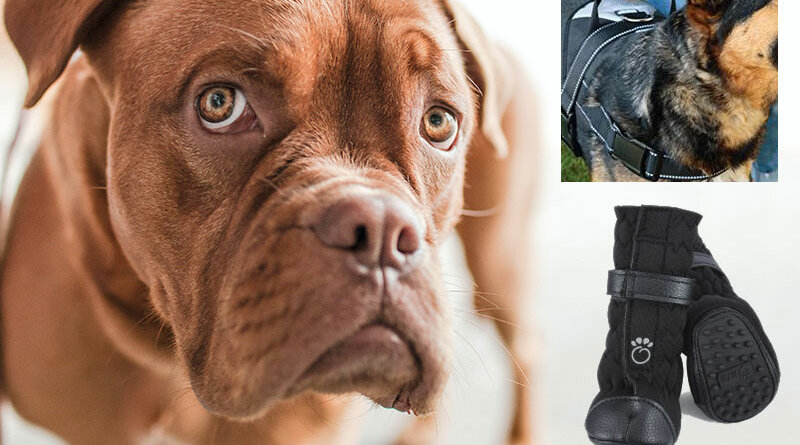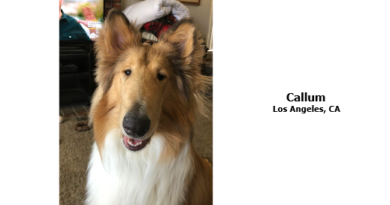5 Tips for Helping Your Dog with Degenerative Myelopathy
When I first noticed Gus, my beloved white Boxer, dragging his back foot, I teased him about being lazy. At age 10, Gus was finally mellowing out after a decade of careening through life like a rodeo bull. Soon, though, he was dragging that foot on our walks, and because we live in an urban (read: paved) area, all that friction began to wear down his nails and scrape the skin from his knuckles.
This was my first indication that Gus had degenerative myelopathy (DM), a disease common in Boxers, German Shepherds and Corgis, among others. An insidious disease, canine degenerative myelopathy affects the nerves of the spinal cord, cutting off communication between the brain and limbs. Over time, the affected dog will become paraplegic and eventually, will be unable to stand at all. While this sounds like very bad news—and it is—there are some silver linings. The first is that, as the disease progresses, your dog will experience very little pain. The second is that you likely have time left together—possibly even years.
To make the best of it, you’ll need a strategy, as well as some new gear to compensate for your pup’s declining mobility. Here’s what helped Gus (and me).
1. Give ’Em the Boot(s) …
Search for “dog boots” on Amazon and you’ll be presented with nearly 800 choices. If that sounds overwhelming, wait until you read the reviews. One man’s “god-send” of a boot is another’s (and I quote) “stupid piece of junk.” After many failed attempts (and a lot of wasted money), I finally figured out that for a dog with degenerative myelopathy, only two things matter: that the boot will stay on despite the repetitive dragging motion, and that it is durable enough to withstand the friction. A boot with a high, adjustable ankle section takes care of the first requirement; flipping the boot upside down is my best advice for the second. I found that placing the boots sole-side-up didn’t affect Gus’s ability to walk in them and meant they weren’t a shredded mess after just a walk or two.
GET THE BARK IN YOUR INBOX!
Sign up for our newsletter and stay in the know.
2. …And the Ol’ Heave Ho
If he doesn’t already, your dog will need rear-end support. Many people use a simple beach towel as a support sling for stairs and slippery flooring. After a few false starts, I found a full-body harness (I settled on this one, but there are lots of others) with a front handle near the shoulder and another near the hips. At first, this allowed me to assist Gus every now and then. Near the end of his life, his “butt handle” as I took to calling it, was essential for helping him use the bathroom and picking him up quickly when he fell.
3. Find a Community
Studies show that physical therapy can more than quadruple the survival time in dogs with DM. I can attest that after his weekly underwater treadmill sessions, Gus seemed a little stronger and more dexterous. But those appointments provided us with something even better—a team. Talking to the physical therapists each week made me feel less alone dealing with the challenges of DM, which can sometimes feel like a lot.
Another unexpected bonus of physical therapy was the veritable lending library of gear at our fingertips. After dogs with DM pass, their owners often donate the cabinet full of boots and harnesses they’ve accumulated. Because of their generosity, we were able to try out different boots and slings, as well as borrow a wheelchair, which can cost hundreds of dollars for larger dogs like Gus.
4. Take Care of Yourself
In the last few months of Gus’s life, when his back legs had all but given out, I carried him up the stairs every night like a wheelbarrow. In the morning, I would hoist him out of bed and ease him down the stairs using that trusty butt handle, which seemed to be in my hands for most of the day. I am not ashamed to admit that facilitating nearly every movement of my 80-pound dog was physically exhausting. Caring for a dog with canine degenerative myelopathy will require your strength, so make sure you’re getting your own exercise in, too.
5. Write It Down
Gus’s DM progressed in stops and starts. One day he crossed the hardwood floor with confidence, and the next, he looked to me for help. Sometimes weeks and months would go by with little sign of deterioration. This made it difficult for me to accurately assess his quality of life, which is an essential factor in the hardest part of this disease: deciding when it’s time to let your dog go. My best and cheapest piece of degenerative myelopathy-related gear was a notebook in which I jotted a few notes each night detailing Gus’s challenges that day, as well as the things he was able to do well. Most importantly, I kept track of his mood and temperament. Not only did these pages help me feel more certain about when it was time to say goodbye, they now serve as a reminder of our time together, and just how much I loved him.
For more information about Degenerative Myelopathy, see here.





buy zithromax 1000mg online https://azithromycin.bar/ where can i buy zithromax uk